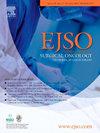The efficacy of immediate lymphatic reconstruction after axillary lymph node dissection – A meta-analysis
IF 3.5
2区 医学
Q2 ONCOLOGY
引用次数: 0
Abstract
Breast cancer related lymphedema (BCRL) is a common complication following mastectomy and axillary lymph node dissection (ALND). Patients with BCRL are often fraught with restricted mobility of the upper limb and higher risk of infections which negatively impact their quality of life. Immediate lymphatic reconstruction (ILR) has gained popularity in recent years due to its positive results in lowering BCRL rates. The objective of this study is to summarize evidence from the current available literature on the efficacy of ILR in preventing BCRL following ALND. A comprehensive search across PubMed and Web of Science was conducted. Studies involving ILR performed at the time of ALND for breast cancer were included. Exclusion criteria included secondary lymphatic reconstruction for established BCRL, literature reviews, animal studies, case reports and studies detailing surgical technique. To evaluate the efficacy of ILR, only studies with both intervention groups (ILR) and control groups were included. A systematic search yielded data from 10 studies and 1487 breast cancer patients who underwent ALND at the time of surgery. Meta-analysis revealed that in the ILR group, 50 of 637 (7.85 %) patients developed BCRL whereas in the control group, 177 of 850 patients (20.8 %) developed BCRL. Patients treated with ILR in this analysis had a relative risk of 0.31 (95 % CI, 0.19 to 0.51) for developing BCRL when compared to the controls (p < 0.0001). ILR decreases the risk of developing lymphedema following ALND for breast cancer.
腋窝淋巴结清扫术后立即进行淋巴重建的疗效 - 一项荟萃分析。
乳腺癌相关淋巴水肿(BCRL)是乳房切除术和腋窝淋巴结清扫术(ALND)后常见的并发症。淋巴水肿患者通常上肢活动受限,感染风险较高,对生活质量造成负面影响。近年来,即时淋巴重建术(ILR)在降低 BCRL 发生率方面取得了积极的效果,因此受到越来越多人的青睐。本研究旨在总结现有文献中有关 ILR 在预防 ALND 后 BCRL 方面疗效的证据。我们在 PubMed 和 Web of Science 上进行了全面搜索。纳入了在乳腺癌 ALND 时进行 ILR 的研究。排除标准包括对已确诊的 BCRL 进行二次淋巴重建、文献综述、动物实验、病例报告以及详细介绍手术技术的研究。为了评估ILR的疗效,只纳入了干预组(ILR)和对照组的研究。通过系统性检索,共获得了 10 项研究和 1487 名乳腺癌患者的数据,这些患者在手术时接受了 ALND 治疗。Meta 分析显示,ILR 组 637 例患者中有 50 例(7.85%)出现 BCRL,而对照组 850 例患者中有 177 例(20.8%)出现 BCRL。在这项分析中,与对照组相比,接受 ILR 治疗的患者罹患 BCRL 的相对风险为 0.31(95 % CI,0.19 至 0.51)(p
本文章由计算机程序翻译,如有差异,请以英文原文为准。
求助全文
约1分钟内获得全文
求助全文
来源期刊

Ejso
医学-外科
CiteScore
6.40
自引率
2.60%
发文量
1148
审稿时长
41 days
期刊介绍:
JSO - European Journal of Surgical Oncology ("the Journal of Cancer Surgery") is the Official Journal of the European Society of Surgical Oncology and BASO ~ the Association for Cancer Surgery.
The EJSO aims to advance surgical oncology research and practice through the publication of original research articles, review articles, editorials, debates and correspondence.
 求助内容:
求助内容: 应助结果提醒方式:
应助结果提醒方式:


